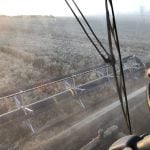Toe tip necrosis syndrome is a hind-limb lameness of feedlot cattle that develops days to weeks after arrival at the feedlot. This disease is also known by many other names: toe abscess, toe ulcer, P3 necrosis, toe necrosis, apical white line disease, apicus necrotica, and the list goes on.
The disease was first described in New Zealand as “transit-related lameness,” but it was Dr. F.L. Sick and colleagues who first described the disease in the early 1980s as an outbreak of “toe abscesses” in feedlot cattle in the U.S. Midwest. While we can debate the name, what is clear is the clinical signs and epidemiology (who it affected and when) are well known.
Sick’s original description of toe tip necrosis is as relevant now as it was 40 years ago. Toe tip necrosis syndrome develops soon after arrival at the feedlot. Lameness is nearly always in the hind limbs, but there is no obvious swelling. Animals may have a fever. The tip of the claws may appear rounded and worn, and on close inspection, there is always evidence of white line separation (the juncture where the hoof wall meets the sole).
Read Also

The Canadian Cattle Association’s international advocacy efforts
Global ag policies affect Canadian food policy, so the Canadian Cattle Association participates in international and domestic forums
Although the cause of toe tip necrosis is open to speculation, the “abrasion theory” is the most likely explanation. This theory postulates that excessive wear along the white line results in separation. This allows bacteria to travel along small fissures within the white line, and a subsequent infection causes more separation. Once the infection penetrates the pedal bone (coffin or P3 bone), then it causes bone necrosis, making it extremely difficult to treat — amputating the claw or euthanasia may be the only options.

The infection can also migrate up the tendons of the hind leg causing obvious swelling. And, in some cases, it enters the bloodstream and seeds bacteria into other organs such as the liver, kidneys and lungs, which results in death. Thus, events and flooring that lead to excessive wear along the apical white line should be considered risk factors for the disease.
Diagnosis is best confirmed with a pair of hoof nippers. Nipping the tip of the claw of an affected hoof will reveal dry and black necrotic horn (hoof) tissue, or it may appear abscessed with a dark grey to black discharge. Nipping is not only diagnostic but also allows the abscess to drain. If caught early, cattle will respond to nipping and antibiotics.
Recently, I worked with Dr. Grant Royan to create an extensive photograph library of the many different floorings used in 24 feedlots and auctions located in Alberta, Saskatchewan and Manitoba. Although concrete is used extensively, it becomes slippery when worn and wet. Thus, some auctions and feedlots apply sand/gravel onto the concrete flooring. While this helps prevent slipping, it is also very abrasive.
Working with Dr. J.D. Johnston at the University of Saskatchewan’s College of Engineering, we recreated white line separation by dragging cadaver feet across different types of surfaces. Specifically, we tested four floorings: concrete, concrete plus sand-gravel, rubber, and rubber plus sand-gravel.
The results were clear; concrete with sand-gravel damaged the feet, and we were able to recreate white line separation, which is the first stage of toe tip necrosis. As expected, rubber flooring commonly encountered in dairy barns was the best material. While rubber mats caused the least amount of damage, they become slick when wet with urine and manure. Thus, bedding (straw, wood chips or sawdust) that accumulates over the flooring will provide traction. One novel idea was the use of skid steer tires, which are both flexible and have deep grooves that provide traction.
We encountered numerous facilities using rebar welded in a grid pattern and placed in front of the squeeze. While this provides excellent traction, it may also be too aggressive for high-strung cattle. Another common flooring is metal forged in a mesh pattern. Again, it provides excellent traction, but risks abrasion. Rubberized floorings are becoming more popular and are typically strategically located in areas such as before and after the squeeze, and in other high-traffic areas. These vary from rubber mats used in the dairy industry to woven tires and skid steer tires.

As the fall run approaches, we urge producers, feedlot and auction owners to evaluate their handling facilities. Check the flooring for jagged concrete, metal embedded in the flooring or squeeze, and flat/angle iron that is welded in areas where cattle can damage their feet and legs. If the concrete is slick, then avoid gravel and use bedding or finer sand. Cattle should also avoid sharp turns, which places torsion on the hoof, which may contribute to white line separation.
Last, low-stress cattle handling is key. The hooves can tolerate poor flooring, but if an animal is excited and pushing on those ahead of them in the chutes, then their hind feet will slip on the floor, which is akin to rasping the claws with a metal file. Sub-optimal flooring is also an issue for highly fractious animals that bolt from the squeeze.
We thank the Saskatchewan Ministry of Agriculture (Agricultural Development Fund) and the Canadian Agricultural Partnership for financial support for this research.
– Dr. Murray Jelinski is the Alberta chair in beef cattle health and production medicine at the Western College of Veterinary Medicine (University of Saskatchewan). His research interests include toe tip necrosis, bovine respiratory disease, Mycoplasmosis in feedlot cattle, internal parasites in yearling cattle, abomasal (stomach) ulcers of unweaned beef calves and the changing demographics of the beef industry and rural veterinary practices.
















